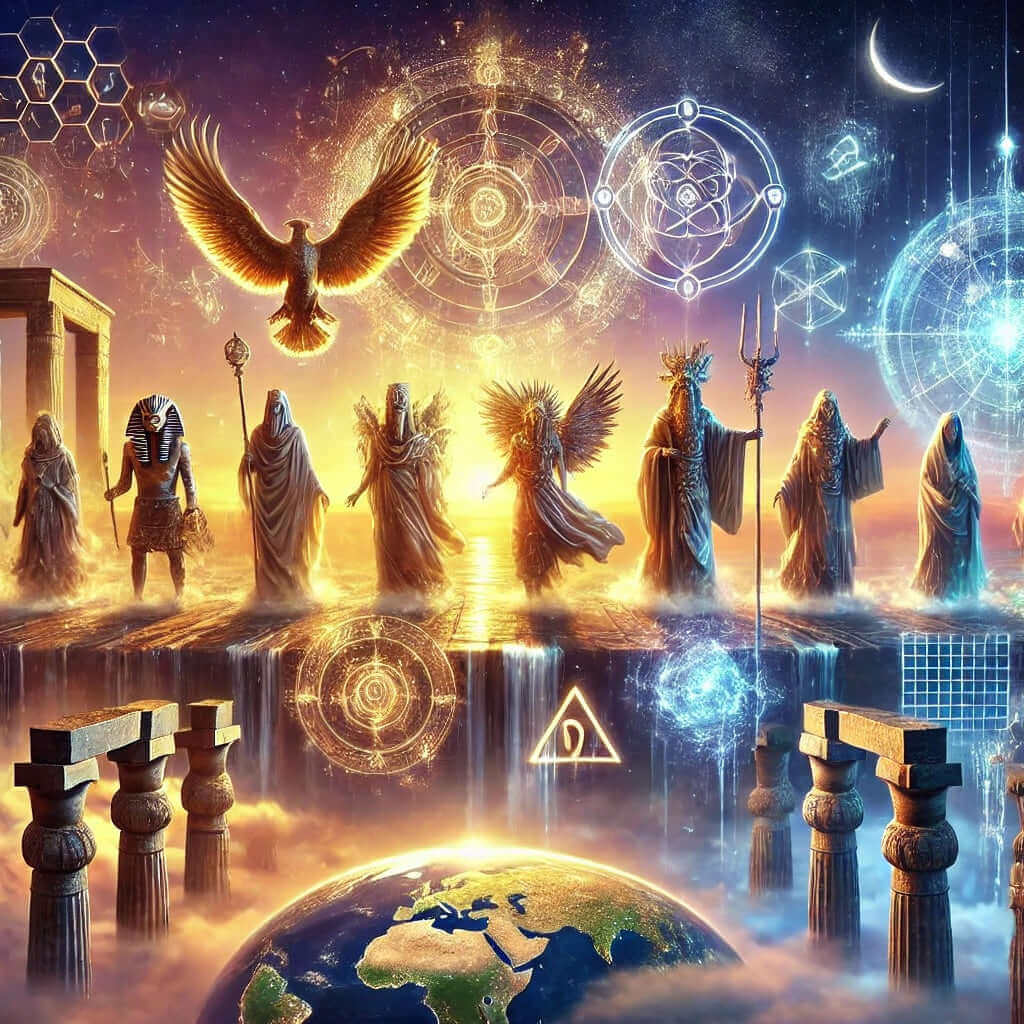
Unveiling the Ancient Ones: Echoes of the Divine Through Time
Share
Welcome to a journey that transcends time and space, where the gods and goddesses of ancient civilizations are reborn through the intricate tapestry of modern design. At NeuroMuse, we proudly introduce the "Ancient Ones" collection, a line that celebrates the deities from some of the earliest cradles of human civilization: the fertile plains of Sumer, the vibrant tribes of Yoruba, and the spiritual depths of Hinduism. This collection is not just about fashion; it's a revival of stories that have shaped human consciousness, depicted through the lens of today's digital artistry.
Themes Across Civilizations
The myths that have spanned millennia are not mere stories but reflections of the deepest human concerns—creation, protection, wisdom, and fertility. From the fertile crescents of Mesopotamia to the sacred temples of Egypt, and from the vast landscapes of China to the islands of Japan, each civilization has molded its deities in response to its environmental and societal needs.
Creation and Power:
- Sumerian Mythology: Anu, the sky god, represents the supreme authority overseeing the cosmos, setting order among the gods and humans.
- Yoruba Mythology: Olorun, the high god, reigns supreme with his distant yet omnipotent influence over creation and life.
- Hindu Mythology: Shiva’s Tandava dance symbolizes the rhythmic cycle of creation, preservation, and dissolution, integral to the universe's continual rebirth.
- Egyptian Mythology: Ra, traveling across the sky and into the underworld, embodies the sun's life-giving and sustaining power.
- Chinese Mythology: Pangu’s emergence from chaos and shaping of the elements portrays the birth of order and structure in the universe.
- Japanese Mythology: Izanagi and Izanami, with their celestial spear, crafted the islands of Japan, demonstrating divine power in geographical creation.
Protection and War:
- Sumerian Mythology: Ishtar, embodying both love and strife, signifies the dual ability to nurture and defend with ferocity.
- Yoruba Mythology: Ogun, the god of iron, forges tools and weapons, representing technological advancement and protection.
- Hindu Mythology: Kartikeya, commander of the divine forces, personifies the warrior spirit, safeguarding the realms of the gods.
- Egyptian Mythology: Sekhmet, as fierce as the midday sun, protects the kingdom through her overwhelming martial prowess.
- Chinese Mythology: Guan Yu, venerated for his valor and righteousness, stands as a guardian against injustice and war's chaos.
- Japanese Mythology: Hachiman, transitioning from agriculture to warfare, protects the land he once fertilized, emphasizing adaptability and protection.
Wisdom and Fertility:
- Sumerian Mythology: Enki, the god of water and intelligence, controls the life-giving waters and the wisdom associated with civilization.
- Yoruba Mythology: Orunmila, the sage, holds the knowledge of destiny and divination, guiding through life's uncertainties.
- Hindu Mythology: Saraswati, the goddess of learning, bestows wisdom essential for life's moral and spiritual dilemmas.
- Egyptian Mythology: Thoth, adjudicator of divine disputes and inventor of writing, maintains cosmic order through his immense wisdom.
- Chinese Mythology: Fuxi, teaching the essentials of civilization, fosters the wisdom necessary for societal development.
- Japanese Mythology: Inari, the deity of rice and fertility, not only ensures the harvest but also imparts the prosperity of knowledge and economic growth.
By exploring these universal themes across various civilizations, we see how ancient cultures addressed fundamental aspects of human existence through their divine pantheons. Each deity, though rooted in their specific cultural milieu, shares attributes with gods from vastly different societies, underscoring the interconnectedness of human spirituality and the shared archetypes that span continents and epochs. This understanding not only enriches our appreciation of these myths but also illustrates their relevance in contemporary times, reflecting enduring human values and aspirations.
Artistic Inspiration and Process
The inspiration for the "Ancient Ones" stems from a desire to illuminate these lesser-known deities, bringing their rich mythologies to a global audience through wearable art. Each design begins with deep historical research to capture the deity's essence. The artistic process blends traditional symbolism with contemporary aesthetics, using AI to sculpt visuals that resonate with both the past and the present. The figures of the gods are depicted not as abstract concepts but as embodiments of their people's traits and appearances, celebrating the diversity of their origins.
Cultural Significance and Modern Relevance
Today, the stories of these ancient deities hold more than just historical interest; they offer insights into human nature and societal evolution. The values, conflicts, and aspirations of ancient peoples mirror our own, reminding us of the universal quest for understanding and control over our surroundings. By wearing these designs, we connect with these timeless narratives, finding common ground with our ancestors in the challenges and triumphs of life.
Conclusion
The "Ancient Ones" collection is more than an homage; it is a conversation between the past and the present, inviting us to explore the depths of human creativity and belief. As we continue to expand this collection, incorporating gods from other civilizations, we invite you to share which deities you feel connected to or wish to see represented. Join us at NeuroMuse in this exploration of mythology, art, and identity—wear the stories of the ancient world as a badge of our shared human heritage.